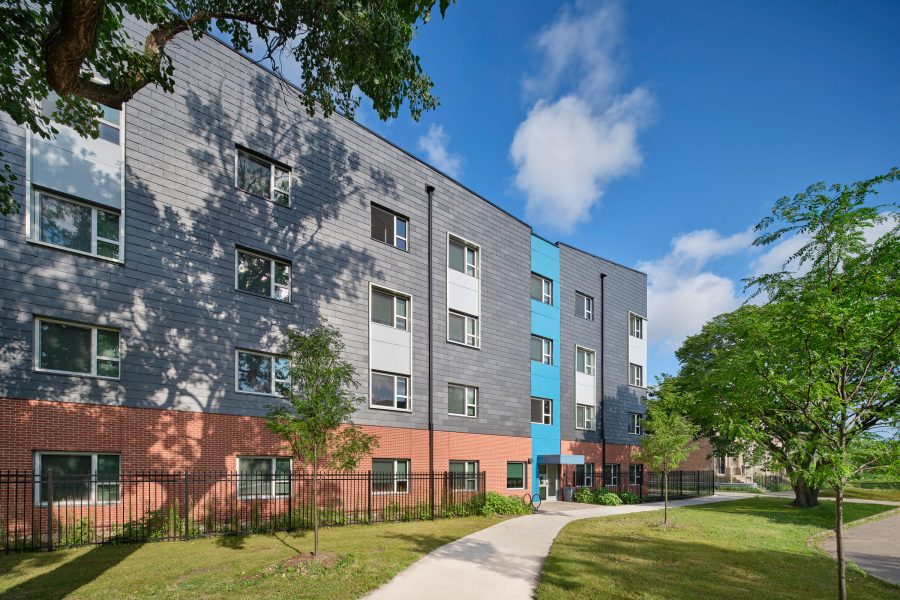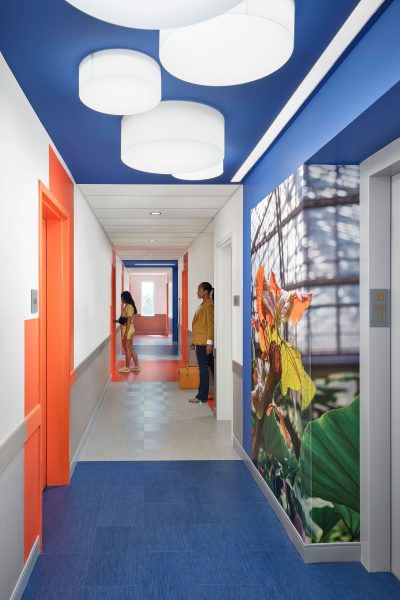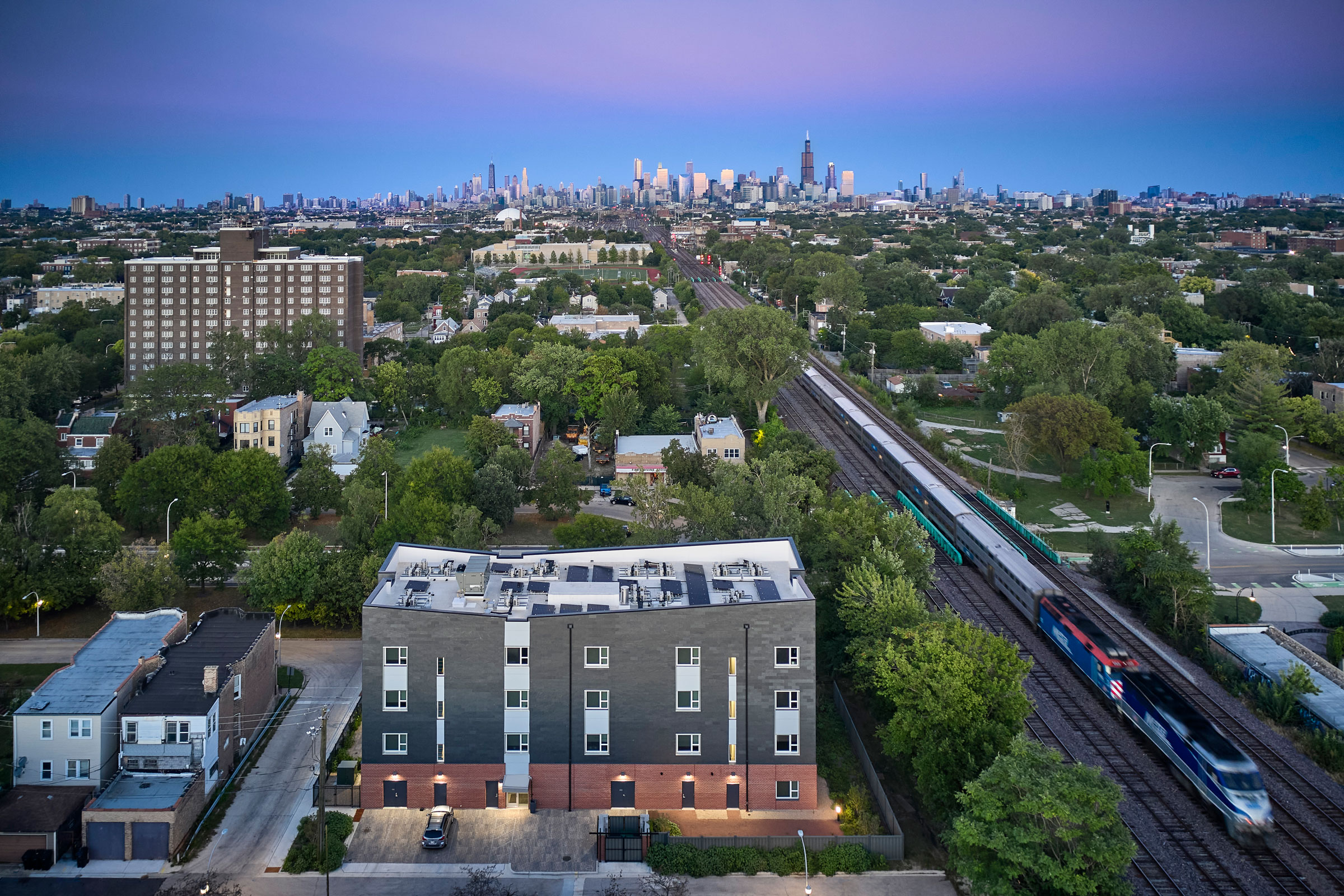Story at a glance:
- The HED-designed Conservatory Apartments is the first affordable housing project of its size to achieve Phius certification in Chicago.
- The 43-unit apartment complies with ComEd’s energy guidelines and has 14 kw photovoltaic systems, Energy Star appliances, LED lighting, and water-saving plumbing fixtures.
No one likes to be a test pilot. However, when HED was enlisted by Interfaith Housing Development Corporation (IHDC) to design the Conservatory Apartments, we were rewarded for stepping into uncharted terrain. By leaning into the challenge of navigating the city’s changing building codes, as well as the state’s new green building incentives, we discovered that aggressive green building could be successful in a large-scale affordable housing context.
In October 2024 the project became the first affordable housing project of its size to achieve Phius (Passive House Institute of the United States) certification in Chicago. The 43-unit project near Garfield Park Conservatory demonstrates that sustainability can—and should—be part of the affordable housing definition.
Raising the Bar

Daylighting and LED lights are among the sustainable strategies inside the Conservatory Apartments in Chicago. Photo courtesy of HED
Like most cities across the country, Chicago grapples with increasing housing shortages and barriers to affordability. Traditionally the financial mechanisms in place to create affordable housing focus on construction costs only, ignoring the long-term operating expenses. Low Income Housing Tax Credits (LIHTC) are the most common tool, and the 9% programs are extremely competitive because they use a scoring system to select funded projects.
While Illinois requires a minimum sustainability standard, slightly above code, in funded projects, higher levels of sustainability from Third Party certifications (i.e. LEED Platinum or Phius) are offered through an optional scoring package in the Illinois Qualified Action Plan (QAP). This is a great step toward addressing long-term affordability, but there have been issues with the points offered not being enough to appeal to developers.
In 2020 I was part of a task force that worked with the Illinois Housing Development Authority to help shift the state incentives toward more advanced green building certifications by offering 10 points for pursuing them. In turn it made competitive sense for developers like IHDC to pursue a higher level of performance certification like Phius. At the same time the city of Chicago issued a new building code and a ventilation reduction pathway to accommodate the stringent Phius energy efficiency guidelines. Ultimately we were able to demonstrate that raising the bar in terms of aggressive green building can work for a large-scale affordable housing project despite being situated in a challenging four-season climate like Chicago.
Implementing Phius Standards

The tight well insulated building envelope consists of walls with an R value of 47 and the roof will be R60 and the foundation and slab on grade will be R20. Photo courtesy of HED
The focus of Phius certification is an extremely tight building envelope that is closely integrated with the mechanical and ventilation systems. Even though the guidelines are also an excellent path to net zero, efficiency is the primary goal. As a result the Conservatory Apartments’ Phius-related features include complying with ComEd’s energy guidelines, 14 kw photovoltaic systems, Energy Star appliances, LED lighting, and water-saving plumbing fixtures (projected to reduce water use by 25%). The building’s transit-oriented location (just 1,320 feet from the nearest Chicago public transit Green Line Conservatory stop) also contributes to the project’s sustainability.
It’s a great-looking, boxy (in the best sense of the word) building that allows for simplicity in terms of efficient infrastructure, such as continuous insulation installation. Notably, the new 2020 Chicago building code allowed us to substitute wood frame for the former code’s masonry/precast requirements. Despite the high costs of building supplies during the height of the Covid pandemic, the savings on superstructure materials opened funding avenues for attaining Phius standards, such as incorporating high-performance windows and HVAC systems. We were also nudged by the city to substitute a durable and beautiful slate rainscreen as exterior insulation in lieu of standard an EIFS (Exterior Insulation Finish System).
Finding the sweet spot between excellent energy efficiency and superb air quality proved to be a tricky balance. Ultimately we worked through stringent ventilation requirements, finding ways to comply with code that allowed us to maintain an energy-efficient building in a Midwestern climate as well as healthy air quality. While we were driven by Phius guidelines, IHDC and HED never lost sight of the importance of human and environmental health in the process of building the project.
Incorporating a Biophilic Strategy

Biophilic design is emphasized inside the building with the lobby’s signature, low-maintenance moss wall. Photo courtesy of HED
Connection to nature is vital for everyone. As the biophilic design trend has bloomed in recent years, various studies have attributed improved well-being, increased productivity, and an array of health benefits to the presence of natural features in homes, offices, and all types of indoor environments. Given that most Americans spend 90% of their time indoors, that connection to nature isn’t a given.
The Conservatory Apartments’ site on a tree-filled boulevard, just north of its namesake, naturally lends itself to biophilia. Due to the project’s selection as part of the Living Building Challenge Pilot Program for Affordable Housing, we were also given the opportunity to bring natural elements inside the building. But in my opinion, the apartments’ coolest biophilic feature is the lobby’s signature, low-maintenance moss wall.
We’ve also simulated natural forms via light fixtures and patterned glass. Four photographic murals—each depicting different images of the nearby Garfield Park Conservatory—lend a sense of place and a dose of nature to each elevator lobby. With another nod to the great outdoors and energy efficiency (and as a resiliency strategy), we also prioritized daylighting, both inside the studio units and in the building’s hallways.
Building a Sustainable Home

Nature is further reflected in murals by the elevators inside the Conservatory Apartments as a nod to the nearby Garfiled Park Conservatory. Photo courtesy of HED
Energy efficiency and creating connections to nature contribute significantly to the sustainability puzzle when it comes to pioneering a new standard for affordable housing. After all, the core goal of this kind of project is to provide good, safe, healthy housing for unhoused people. Thirty-four of the Conservatory apartments will accommodate chronically homeless individuals and people with disabilities. The remaining nine units will be allocated to people through the Illinois State Referral Network with support services via nonprofits, Deborah’s Place and Trilogy Behavioral Healthcare.
Being the first is worth it as long as we’re not the last. Building livable and sustainable housing means creating a space that is fiscally and environmentally healthy well into the future. Although pricing for green building features and materials are rarely the cheapest option, the Conservatory Apartments are proof that resisting the short-sighted tendency to cut these upfront costs will pay off in the long run. Adhering to green certifications saves money over time. In the affordable housing equation, that matters.

